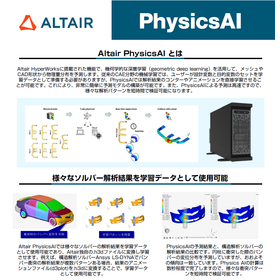■ Magnetic field analysis software (combined method, frequency response) EDDYTMjω
PHOTO-EDDYTMjω
3D magnetic field analysis software (magnetic field simulator) using a combination of finite element method and H-method *No air mesh required.
■ Magnetic field/magnetic field analysis software (magnetic field simulator) using a combination of the finite element method and H-method, capable of performing static analysis and frequency response analysis. ■ Can handle three-dimensional problems. ■□■ Features ■□■ ■ Can create analysis models without creating air regions. ■ Integrated with the PHOTO series dedicated pre- and post-processing, allowing data creation, analysis, and result processing to be performed as a single operation. ■ Achieves revolutionary speedup through the combination of edge element method and ICCG method (dozens of times faster than conventional finite element methods). ■ Provides stable solutions using the finite element method, making it safe for beginners to use.
Inquire About This Product
basic information
■Linear analysis of conductive materials can be performed. ■Linear analysis of magnetic materials can be performed. ■Analysis of superconductors can be performed. It includes highly flexible input for superconducting properties (when using user subroutine functionality). ■The skin layer creation function allows for easy creation of skin meshes. ■For other features and details, please download the catalog or contact us.
Price information
-
Delivery Time
Applications/Examples of results
■□■Applicable Fields■□■ ■Fields requiring simulation of phenomena involving eddy currents ■Linear motors, magnetic heads, non-destructive testing (eddy current testing), induction heating, free electron lasers, induction machines, RFID-related applications, etc.
catalog(1)
Download All CatalogsCompany information
At Photon, we are developing "electromagnetic field analysis software" that models and simulates products and components utilizing electromagnetic phenomena on a computer. In traditional design and development environments, the process has primarily revolved around trial and error through prototyping based on the experience of engineers and experiments with prototypes. However, conducting experiments using actual prototypes and analyzing the results requires significant time and cost. Moving forward, transitioning from an experimental and prototyping-based approach to an analysis-based design approach will be a crucial challenge for improving productivity, and establishing simulation technology as the core of analysis-based design techniques will be essential. In this context, Photon is developing and providing "analysis software" focusing on electromagnetic fields, as well as heat, vibration, and sound fields. By utilizing Photon's software, efficient development and design of various industrial products can be achieved. In this way, Photon aims to support users in reducing the number of prototypes, lowering development costs, and shortening development periods in their manufacturing environments, ultimately enhancing their competitiveness.






![[Analysis Case] Nonlinear Static Magnetic Field Analysis of Magnetic Shielding](https://image.mono.ipros.com/public/product/image/c3f/2000766416/IPROS20683722587076620196.png?w=280&h=280)





![SOLIDWORKS 2026 New Features Seminar [Free Participation]](https://image.mono.ipros.com/public/default/object/noimage_l.gif?w=280&h=280)